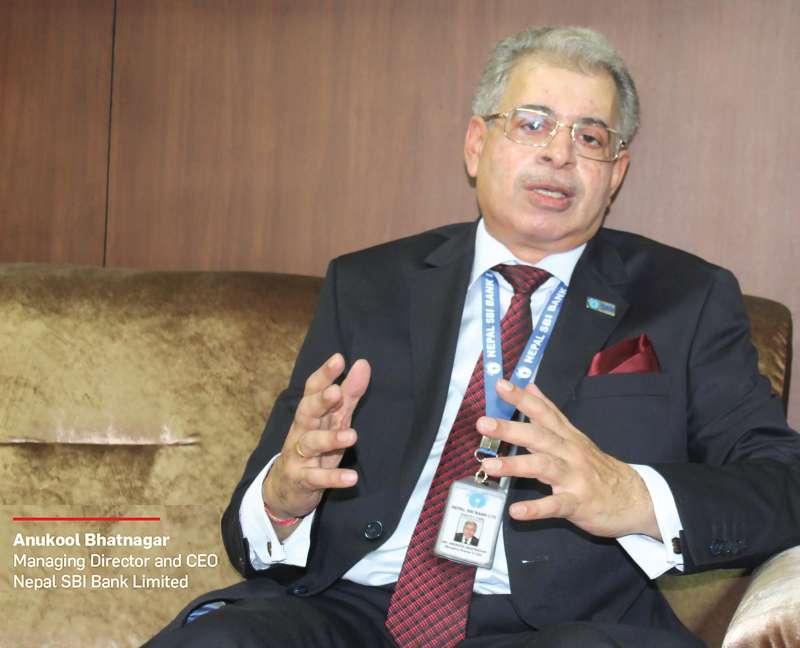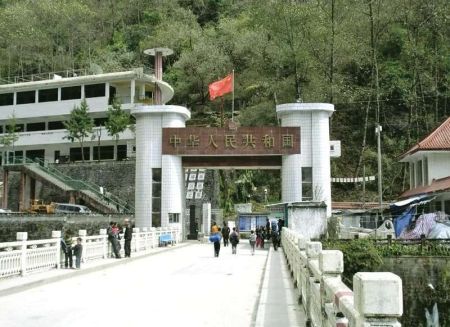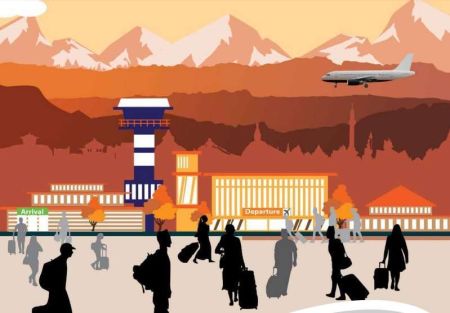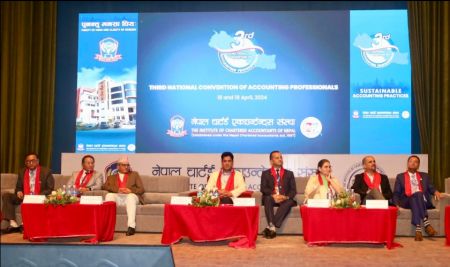The first Nepal-India joint venture bank Nepal SBI Bank Limited (NSBL) recently celebrated its 27th anniversary. Over the years, the bank has established itself as a major player in the Nepali banking sector with its focus on banking innovation, use of technology and efficient banking services to cater to the needs of its one million strong customer base. In an interview with New Business Age, Anukool Bhatnagar, Managing Director and CEO of NSBL and the Vice President of Nepal Bankers’ Association, talked about NSBL’s plans and activities, impacts of Covid-19 in the banking sector, changing trends in banking services, current challenges, among other topics. Excerpts:
What achievements would you like to highlight in the 27 years of operations of Nepal SBI Bank Limited (NSBL)?
NSBL is very proud to stand up to the expectation of its vision to be the most preferred bank for a transforming Nepal.
With its mission to provide high quality reliable and innovative financial solutions adhering to values of service, transparency, ethics, politeness and sustainability, NSBL has very ably dealt with the challenges of serving all its stake holders. NSBL is now a full services bank serving its one million customers through its 116 offices located in 53 districts of Nepal.
What areas of banking do you think Nepal SBI has excelled in over these years and what are the areas of weakness that the bank still needs to overcome?
NSBL has aligned its commercial priorities with its commitment to the plans and programmes of the Nepal government.
The bank has excelled in its service to the nation and in providing broad services at affordable rates. Further growth of financial inclusion, financial literacy and digitisation of banking services remain some of the challenges still to be faced in the coming years.
What are the priority areas for Nepal SBI in terms of business expansion and customer service?
NSBL is endeavouring to utilise its experience and expertise in catering to the banking requirements of diverse sectors such as manufacturing, infrastructure financing, agriculture, micro, small and medium enterprises (MSMEs) and self-employment job creating activities. It will leverage its linkages with its group enterprises operating in 30 other countries in introducing new digital technologies and platforms for cross border trade and remittances.
What areas of investment is Nepal SBI eying in the short, mid and long term?
NSBL is currently focused on investing in its IT platform capabilities and establishing strategic tie ups across the world for business growth. Going forward, the bank would be looking at business reengineering linked to emerging development trajectories. In the long term, NSBL would like to play a much more active role in projecting the Nepal financial services sector beyond Nepal’s borders in scouting for investments and trade opportunities. This would entail operating NSBL’s branches in strategic international centres.
The Covid-19 pandemic has ravaged economic activities in Nepal for the last couple of months. How has the current crisis do you think affected the Nepali banking industry?
Owing to the ill effects of the health crisis on the socio-economic patterns in Nepal, the Nepali banking industry has had to face new and unimaginable challenges on all fronts. Being an essential service, it has stood up fully to its responsibilities and has provided uninterrupted banking services to all sectors. Slowdown and change in economic activities have posed tremendous and dynamic stress and strain to banks. In its spirit of public service and as a true financial intermediary, the banking industry provided selfless service on a non-commercial basis.
Providing below cost electronic services and concessions/ moratoriums to individuals and borrowers while at the same time ensuring continuity of services, honouring ‘on the date’ commitment of interest and principal payment to its own depositors and looking after the welfare of its employees and customers, has been the singular highlights of the Nepali banking industry.
How has it impacted the operations and business of Nepal SBI and how is the bank facing the current challenges?
NSBL being the practical banker it is and also an agile and learning organisation, quickly understood the changing business landscape and socio-economic environment. With its unique access to loyal customers and employee talent, the bank transformed its style of working. Redundancy identification, austerity adoption, and coevolution with its stakeholders, NSBL accelerated the scope and scale of its digital initiatives. Working from anywhere, provision for providing banking services to the customers digitally at their doorstep and diversification of on-line options were rolled out. NSBL’s timely and adequate recalibration of its interest rates, service charges, providing bridge credit facilities and an empathetic attitude has resulted in it still maintaining the lowest NPA ratio in the commercial banking segment in Nepal.
Nepal Rastra Bank (NRB) announced a slew of measures in the Monetary Policy for FY2020/21 with an aim to provide relief to the crisis-stricken sectors. What are the most positive aspects for you in the policy or are there any shortfalls in the announcements?
In my opinion, the Monetary Policy for FY2020/21 has signaled a monumental change in policy directions. Some salient features stand out. For instance, the directed flow of credit as per the new recalibration of the financial sector to priority sectors would boost basic economic activities in the agricultural, MSMEs and retail sectors. This would support import substitution in food grains and agricultural produce, while at the same time boosting development of rural infrastructure and financial inclusion.
The singular allocation of 15 percent of bank credit to MSMEs with broad based credit spread to enterprises utilising credit of less than Rs 10 million, is likely to create tremendous self-employment opportunities. The energy sector and related industries would see renewed infusion of cheapest funds. Availability of adequate refinancing avenues is a tangible upside.
Do you think the measures will be sufficient to take the country’s economy out of the slump?
For a financial resource thin nation like Nepal, in these times of global turbulence, the interventions are timely and adequate. It is now for all the stakeholders and the institutions to take heed of the call of the nation and put their best learnings and entrepreneurship into play.
Bankers seem to be particularly dissatisfied by the loan repayment deadline extension and some other measures in the Monetary Policy arguing that these will increase non-performing assets (NPAs) of banks. What is your take on this?
The Covid-19 pandemic and other externalities as well as compliance to complex monetary and fiscal policies, directions, have definitely placed the banks in a clear disadvantaged spot. Regardless of satisfying the often conflicting demands of their stakeholders viz. shareholders, regulators and customers, banks are faced with ‘saving the savers’, ensuring a decent comparative return to the large number of depositors and investors while providing credit at a reasonable and sustainable cost and flow to borrowers subject overall to very transparent and ethical balance sheet management and regulatory oversight. Slowdown in socio-economic activities has naturally impacted the repayment capabilities of businesses leading to enhanced risks, forbearances, loss given defaults (LGDs) and expected credit losses (ECLs). Rapid expansion of lending to the bottom of the pyramid in agriculture and MSME sectors and rural areas spread across the geography of Nepal may result in pockets of high NPAs and delinquencies. However, the real hidden challenge for banks is to get investors to shift their capital from weaker or overleveraged firms to more efficient ones and thereby to improve the overall capital efficiency in the economy. Change of behaviour from collateral-based lending to lending against cash flows would definitely rein in NPAs.
As the Covid-19 pandemic has changed the conventional ways of doing business over the past four months, what are your observations on the changes taking place in the banking sector?
The Covid-19 pandemic is not the primary cause of the challenge. The global slowdown had already been underway for some time but the multiple risks and shortcomings in systems and institutions have only now been exposed. Maintenance of asset quality at lower margins and lower economic demands, have forced the banking sector to have a really close and granular look at its constraints and opportunities. From cutting down its fixed costs to adoption of online digital formats as banks foresee a business scenario of operating at lower capabilities in the medium term, to being constantly exposed to constant and dynamic risks would change the conventional way of doing business forever.
How is Nepal SBI Bank gearing up to the changing scenario in terms of digitisation and introducing innovative solutions in banking?
Disruption is a catalyst for action. NSBL carries the soul of a public sector bank (its major two JV investors are public sector entities) in the body of a private bank. Leading by versatility, we have accelerated the speed and scale of our digital journey. Rolling out of virtual branch formats, ‘Work from Anywhere’ models, adopting SBI’s hugely agile and pivotal YONO (You Only Need One) mobile banking platform to Nepal’s requirements are our top priorities. ‘Don’t just build back better, build back different’ software solutions are exciting us as we prepare to digitise the financial inclusion and lending models to hand held devices to cater to the expected expansion in the sectors of small agriculture, MSME and retail in rural Nepal.
We are in the final stages of opening a huge number of ‘Nepal Desks’ in SBI offices in India and in SBI operations across many countries of the world to facilitate business advisory, access to remittance and account maintenance through safe and reliable platforms for Nepali nationals.
As a foreign bank, how much support is Nepal SBI getting from Nepal Rastra Bank? How much attention is the banking sector regulator giving to the concerns of foreign banks in Nepal?
NRB has been extremely open and receptive to knowledge sharing and leveraging the technical expertise resources of foreign JV Banks. NRB has very high expectations and provides huge support and encouragement to our endeavours in ‘Open Shaping’, ‘Sandboxing’ and introduction of higher standards in assessing risk parameters, compliance and reaction thresholds as well as in capacity building and strategic collaborations. Since its inception 27 years ago, Nepal SBI has never had any unresolved issue pending with NRB.
Finally, would you like to highlight anything else?
Looking at Nepal’s banking sector through the prism of the future, I see a huge positive challenge in playing a vital role in the socio-economic advancement of the country and its quest towards autarky, achievement of universal financial inclusion, its fight against the drain of intellectual and economic capital, and our collective resolve to place Nepal on the world’s space as a vibrant financial and commercial centre. In the words of Martin Luther King Jr.
“The ultimate measure of a man is not where he stands in the moment of comfort and convenience, but where he stands at times of challenges.”






















